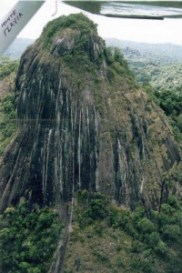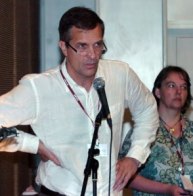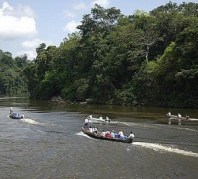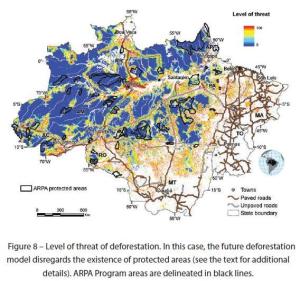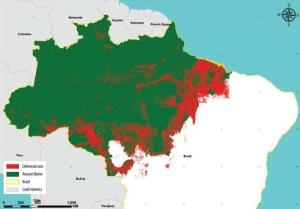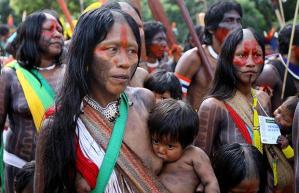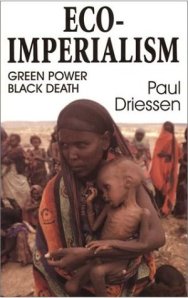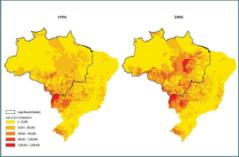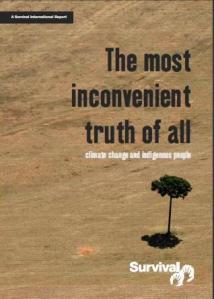Jan 06
20180
Conservation International, National Wildlife Federation, Natural Resources Defense Council, Nature Conservancy, Sierra Club, World Wildlife Fund (WWF)
Clean Development Mechanism (CDM) Conservation International European Commission International Monetary Fund Mark Tercek National Wildlife Federation Natural Resources Defense Council Peter Kareiva Sierra Club The Nature Conservancy United Nations World Bank WWF
Environmentalism and Democracy in the Age of Nationalism & Corporate Capitalism
December 14, 2017
by Clive Spash
Recently my masters’ students and I watched the film Carbon Rush. This reveals how numerous carbon offset projects – under the Kyoto Protocol’s emissions trading related Clean Development Mechanism (CDM) – are devastating the lives of some of the poorest and most vulnerable people in the world, and simultaneously destroying the environment on which they depend for their survival. CDM projects (such as dams, waste incinerators, wind farms, commercial forestry and oil palm plantations) suffer from dubious or no additionality and may as easily increase as reduce net greenhouse gas emissions. Yet, the international climate community commonly regards offsetting as central to climate change policy. Such schemes have proliferated due to the desire for making money out of environmental crises and a total disregard for exploitation of the poor and weak, the very groups that ‘development’ (clean or dirty) was supposed to help. In the neoliberal era the rule of the banking and finance sector and multi-national corporations means prioritising making profits by shifting costs onto others; something that has long been recognised as the modus operandi of the business enterprise (Kapp, 1978).
Environmental commodification, trading and offsetting are business as usual approaches to environmental policy. Whether converting wetlands into bankable assets as in the USA or greenhouse gases into tradable permits as in Europe, the justification is that the preservation of the capital accumulating growth economy requires mechanisms that institutionalise the ‘right’ to undertake environmental degradation. There is also consensus across political divides about the need for economic growth. In the UK, neither Corbyn (Labour) nor May (Conservative) had any meaningful environmental agenda, and both their parties remain totally committed to a growth economy. Diverse nation states are similarly united in promotion of environmental crises as growth opportunities. For example, the European Union and China are pushing the rhetoric of ‘Green Growth’. This combines increasing domestic greenhouse gas emissions through the extension of market based mechanisms and offsets with the promise of new future technologies as the ultimate ‘solution’ to address those same emissions. Faith in markets and technology remains core to international climate policy and unaffected by whether the USA is in or out of the Paris Agreement. Similarly, faith in markets and technology as environmental saviour would have remained the same regardless of having Trump or Clinton in the White House.
In actual fact, the USA has never been a leader in greenhouse gas emissions reduction or climate policy, and both Democrat and Republican administrations have contributed to weakening international treaties. The Paris Agreement was watered down at the behest of the Obama administration compared to a more rigorous treaty, with common base year and targets, recommended by the European Commission (Spash, 2016a). Obama made clear his commitment to protect American jobs over the environment and specifically over any need to address human induced climate change. In this logic, environmental policy is justified if it creates jobs and growth, which always come first despite the inevitable contradictions. Obama’s administration massively expanded domestic oil and gas exploration to make the USA the worlds largest oil exporter (Spash, 2016a: 70). Non-conventional oil has been part of this strategy, despite the world already having over 6 times the reserves it could possibly burn and still have a ‘likely chance’ of the 2°C target (Spash, 2016b). Obama boasted that under his administration enough oil and gas pipelines had been built to ‘encircle the Earth and then some’ (see full quotation in Spash, 2016a). He ignored the associated ecological and social harm, not least that to indigenous communities. In 2016, Native American protestors at Standing Rock opposing construction work on the Dakota Pipeline that, now operational, transports fracked oil, were brutally suppressed by the combined efforts of the construction corporation’s security forces, riot police and the national guard. All that was before the election of a climate denialist with personal investments in fossil fuels.
The USA is one amongst many nations putting their own interests before the common good, and with a record of saying one thing and doing another. Modern development is allied to a military-industrial complex that ensures nation states work to secure, maintain and expand their fossil fuel resource supplies at all costs. Current fossil fuel and infrastructure polices totally contradict the supposed commitment of nations to the Paris Agreement, and its already exceeded, scientifically unhinged, target for a potentially catastrophic 2°C average global temperature increase (Spash, 2016a). Meanwhile, the
United Nations, the European Commission, the World Bank, the International Monetary Fund and similar international bodies have continuously pushed market approaches that fail to address biophysical reality, permitting exploration for and exploitation of fossil fuels leading to emissions that should never have been allowed. Thus, there is no surprise that recent moves by the airline industry to justify its plans for 700% expansion by 2050 rely on carbon offsetting, while numerous governments (e.g. Austrian, British, French, Turkish) support airport expansion as an economic necessity to create domestic jobs and growth.
Sadly, over the last two decades, in the midst of our ongoing ecological and associated geo-political crises, a range of environmental non-governmental organisations (ENGOs), rather than opposing such schemes, have formed alliances with some of the worst corporate polluters and resource extractors in the world and now actually promote them (Spash, 2015a). Greenwashing has become a major occupation for ENGOs. Many have become apologists for corporate self-regulation, market mechanisms, carbon pricing/trading and biodiversity offsetting/banking, while themselves commercialising species ‘protection’ as eco-tourism. Foremost amongst the neoliberal ENGOs is The Nature Conservancy (TNC). Its President and CEO is Mark Tercek, previously a managing director at Goldman Sachs. Its Vice President until recently was Peter Kareiva, a key player in the Stanford University flagship ‘natural capital’ project with its mission to convert ecosystems into environmental services that can be traded off. Together Tercek and Kareiva have promoted capitalism as natural and berated conservation biologists for not allying with corporations. In a revival of social Darwinism, Kareiva has even claimed that corporations are a keystone species!
ENGOs have been deliberately targeted by corporate strategists and in several cases they have been captured at management level. For example, Holmes (2011) reports on some of the boards of American ENGOs that include large numbers of current or former directors of major transnational corporations:
TNC 15 out of 26; Conservation International 26 out of 36; WWF-USA 13 out of 21. In addition, ‘these NGOs each have a business council, made exclusively from corporate directors, to advise the board of directors’ (Holmes, 2011: 9). Besides TNC, Conservation International and WWF, Hari (2010) cites the National Wildlife Federation, Sierra Club, and the Natural Resources Defense Council as all suffering from corporate capture and conformity to the basic tenets of neoliberalism. This is the spread of what I have referred to as new environmental pragmatism (Spash, 2009). The inroads into conservation by corporate interests are deep. Recently, Adams (2017) has analysed the pragmatic reasons behind this alliance, terming it ‘sleeping with the enemy’ and a ‘Faustian bargain’, that is sold as promoting the mythical Green and growing economy. There is, then, much to concern environmentalists about the role of environmentalism today and whether it can help or will hinder the achievement of a more just, ethical and equitable future.
In this issue of Environmental Values the state and direction of the environmental movement are at the fore. The extent to which conformity to current institutions and their values is regarded as pragmatic is the topic addressed by D’Amato et al. They contrast such pragmatism with the need for revolutionary change and consider which will achieve social ecological transformation. That ‘business as usual’ might no longer be an option leaves open what that implies for the existing political economy (from high-tech competitive corporate growth to low-tech cooperative community degrowth). However, as mentioned above, the hegemonic approach is techno-market optimism with the promise of preserving and protecting the current capital accumulating economic system.
Productivist rhetoric is dominant in government circles and provides an imaginary that can fit with liberal, neoliberal, social democratic welfarist, socialist and centrally planned political systems. While some things must change the utopian vision of a ‘sustainable growth economy’ will not be surrendered.
The sustainable development agenda, from Norwegian premier Gro Bruntland onwards, has seen no conflict between achieving social and ecological goals and maintaining the growth economy. The United Nations has spent decades pushing various brands of ‘sustainable development’ as economic growth, with the Green Economy its latest incarnation (Spash, 2012). The basic aim is to make capital accumulation resilient, whether in the West or East, under democracy or despotism, whether state or corporate owned and run. How then should the environmentally concerned address this hegemony?
D’Amato et al. provide a new classification of the debate based upon qualitative interviews and a focus group with twenty young researchers working in the area of social ecological transformation. They contrast perceptions of the role of research as extending from promoting a simple form of pragmatism through to radical change based on strong value commitments. The mode of social change regarded as necessary is described as extending from a gradual evolution to a radical revolution. The concept of the Green Economy was classified by respondents as falling within the pragmatic and evolutionary. The majority (60%) of respondents themselves held the pragmatic revolutionary position, followed by those classified as radical revolutionary (25%) and pragmatic evolutionary (15%). Thus, while 85% of these young researchers felt revolutionary social change was necessary, 75% believed research should be pragmatic. While qualified by this being a small convenience sample, the findings do indicate the potential prevalence of new environmental pragmatism and supports previous work indicating that this is a wider phenomenon amongst researchers (Spash and Ryan, 2012). More generally, D’Amato et al.’s work raises some serious questions over the general direction of environmental research and how far researchers are prepared to make their work conform to hegemonic values, norms and practices, including those they in principle oppose.
Yet, those who stick to their principles are often described as fundamentalists or uncompromising radicals who deny democratic process. Amongst environmentalists, animal activists have typically been painted as such extremists with their claims based on contentious rights based arguments. In some (supposed) democracies they are even regarded and treated as terrorists. Parry raises the issue of how animal activists should operate within an idealised deliberative democracy and what they could then legitimately justify doing to further their cause. The arguments for and against the use of different campaigning tactics are raised with specific attention given to the example of using video footage showing animal suffering. Such tactics are described in terms of creating a moral shock. Can this be legitimate in a democracy?
Parry makes the case that deliberative democracy offers a justification for representing animals in decision making, but that this does not require appeals to claims about moral worth. Instead existing democratic political principles and institutions are invoked. Three principles are then given, namely that deliberative democracy should be inclusive, authentic and consequential. Parry’s article evaluates animal activism on these grounds.
Inclusion refers to the right of representation in a decision on the basis of having interests that are subject to being affected by that decision. Political theorists have criticised animal rights activists for using undemocractic/deliberative approaches, which they claim are unjustified because these activists are just another group of humans seeking to promote their own interests. Such theorists believe animal activism should be undertaken through ‘normal’ democratic processes. However, as Parry points out, this is a conversion of human to non-human relations into a human to human relationship. Central to the politics of non-human Nature is the representation of silent voices (O’Neill, 2001). How the non-human get a voice in the human world is the central question here.
One aspect of the problem is the tension between attribution of value on the basis of possessing human-like qualities and possessing value despite clearly being non-human like (see for example Coyne, 2017; Vetlesen, 2015). The value basis of interests is then a core concern. Contra Parry, the application of deliberative democratic principles does not then seem to avoid the need for adopting a value basis, nor the need for moral reasoning. Notions of value are employed both in arguments for moral standing and rights of political representation.
A common approach in determining such attributions is to appeal to sentience and the ability for non- humans to suffer pain like humans. One reason is the search for generalisable and common interests, which are regarded as constituting authentic deliberation. Here there is an implicit appeal to Kantian moral criteria for establishing a valid moral argument, so once again contention over moral positions appear unavoidable.
Parry’s second concept, authentic deliberation, aims to encapsulate the desired qualities of democratic deliberation, namely: truthfulness, mutual respect, non-coercive persuasion, constructively seeking acceptable outcomes, reflexivity and prioritisation of generalisable interests. Parry then explores how far different tactics of animal activists match such qualities, and the same is undertaken for the third concept, that requires deliberative democratic criteria be consequential. The latter entails identification of discernible impacts of tactics on decisions, where the consequences are evaluated at a systemic level (i.e. taking into account various aspects of repercussions). Put more crudely this is an assessment of ends justifying means.
The question Parry debates is the extent to which the tactics of animal activists are non-democratic and yet still might be justified. Two tactics classified as non-democratic are imposing costs on others and the rhetorical exaggeration of moral disagreement. The former covers the making of an action (unwanted by activists) financially more costly for the actor, but is also extended by Parry to include imposing psychological costs on such actors. The latter concerns highlighting moral differences to emphasise what is deemed unethical. Such tactics are problematic for deliberative democrats – being termed exaggeration’ and ‘rhetoric’ – because of their commitment to political process as a consensus-seeking compromise. As Parry notes, in passing, there are those arguing that the worth of democracy lies in allowing for contestation over values, and that would involve the recognition of differences held as moral principles rather than seeking compromise and reasons to justify why everyone make trade-offs. A possibly related issue (not addressed) is the apparent contradiction involved in evaluating a social movement that emphasises deontology, community responsibility and duties on the basis of consequences and individual action.
Parry concludes that some of the non-democratic tactics of animal activists may have a role, but should be employed with reflection and moderation. In reaching this conclusion some aspects are only briefly mentioned, but seem central to any justification for radical action within the social reality in which we live today. Perhaps most important are the inequity in power relationships in society and the undemocratic state of the institutions empowered by the idea of a neoliberal economy. Such things as corporate power, greed and the capital accumulating economy lie behind the prevalence of threats to the nonhuman world. The associated institutions perpetuate and legitimise a range of practices against the interests of both non-human and human animals. In the struggles of indigenous communities, who are on the frontline of the extractivist economy and its accumulation by dispossession and land grabbing, there are few signs of legitimate democracy let alone the deliberative democratic ideal. How to live up to the ideals of deliberative democracy, in seeking to right some wrongs, seems of lesser relevance than asking how and by what means can the transformation of such an undemocratic system be achieved? Related to this is the question: what are the legitimate grounds for the institutionally powerless to fight institutionalised power?
Quist and Rinne are concerned with the challenges that disenfranchised groups face in building shared agendas and expressing themselves in their struggles to protect the environment and their ways of life. Their particular context is the conflict between different forms of resource exploitation and specifically fisheries versus oil extraction. They present a case study from Mexico that investigates media (two regional newspapers) representation of the conflict over access to the sea after Pemex, the eleventh largest oil corporation in the world, was empowered by the Mexican State to create marine exclusion zones. They reveal how the media operates with implicit rules of newsworthiness that play to the dominant moral discourses promoted by political and economic elites. In addition, they expose how this has played up divisions within the fisher community (e.g., between licence holders and other fishers working for them or independently).
The central concept in their case study is ‘patrimony’, or regarding natural resources as an intergenerational heritage that creates a community understanding and sense of common purpose. Under patrimony the community is typically the nation state, with patrimony operating as national heritage, but the study identifies how the concept is also applied at the fisher community level by its leaders. However, rather than being empowered, the fishers appear to be captured by the discourse of patrimony, while their own discourse, expressing ecological values that include their way of life, is excluded. Fisher leaders are shown to adopt the patrimony discourse against the interests of the wider fisher community, even to the extent that the prospect of fishers becoming oil workers is considered. Oil is judged superior in patrimonial value and for the national collective compared to the value of fishing for the local community. In this discourse, there is no questioning of the oil industries right to exploit the resource. There is a clear underlying productivist logic that excludes environmental concerns and narrowly frames the social as national.
How natural resource extraction issues are framed by the media is also the concern of Davies et al. Their particular case study is Greenland, where the population of 57,000 live in the twelfth largest country by land area. That 90 per cent of the people claim Inuit ethnicity adds to the distinct character of the society, as does having 80 per cent of the country under ice. In this last respect, climate change has been presented by some as an opportunity for opening-up territory for resource extraction. Indeed, this forms one of the major discourses revealed by Davies et al. in their analysis of 1000 English language media articles about Greenland. The potential for extracting oil, gas and rare Earth metals to supply the fossil fuel economy and its high-tech industries means climate change is not denied but accepted as an actual phenomenon by corporate fossil fuel and resource extracting interests. Rather than being a problem, climate change is seen as an opportunity. The media being reported here seems clearly focused on serving the speculations of corporations, bankers and financiers over where to make money. Such media coverage regards risk purely in financial terms of returns on investment (not strong uncertainty over climate change), and on the same basis the potential for oil spills due to new extraction is addressed as a risk to corporate investors’ returns, not the environment.
Other aspects of the media coverage over extracting Greenland’s resources relate to the geo-politics of a small Inuit led country facing the likes of China and the European Union, and multi-national corporations. The vulnerability of Inuit culture is also raised, including the potential impact on the relatively small existing national population being swamped by incoming labour. Yet, somewhat paralleling the case of Mexico, coverage also regards investment in resource extraction as a necessity for ‘development’ that promises jobs and the eradication of social problems through material wealth.
The idea of wilderness, so antithetical to advocates of the anthropocene (Baskin, 2015), appears in the media in both its positive form as pristine and untouched, as well as its negative form of waste land. The absence of human use is bemoaned by the latter as resources going to waste, while for the former this is where the environmental value lies. However, what is interesting in the reported media coverage presented by Davies et al. is how human–nature interactions are so easily turned into, and exclusively discussed as, human to human value relationships (e.g. human induced climate change having consequences for humans). Nature then has no voice in this media coverage.
Therein lies the failure of the environmental movement in its pragmatic neoliberalism. That the mainstream media is obsessed by framing its reportage in terms of financial and economic consequences is hardly a secret (see Chalmers, 2012). What is less readily admitted is the extent to which ENGOs have done likewise and so lost their connection to the non-human world that environmentalism aimed to represent in the first place. In the appeasement of presumed state and corporate economic interests, the language of environmental values is commonly reformulated to actually deny the existence of value in nature, non-human to non-human value and even the importance of human to non-human relationships. There is only the human-to-human relationship and associated values, and clearly some humans are more equal than others.
Issues of power, inclusion and representation in the environmental movement also concern the paper by Fenney, but from a different perspective. The argument is made that the disabled are subject to both oppression (disablism) and also the assumption of a non-disabled norm as valid and desirable (ableism). Evidence from interviews with disabled people in the UK is presented to illustrate the issues. In particular, Fenney highlights discourses on cycling and self-sufficiency as problematic. The former is criticised as specifically focussed on the able bodied, while the latter is seen as promoting a form of independence that is unavailable to many disabled people. Both are then loosely associated by Fenney with a neoliberal agenda in environmentalism.
The broader concern raised by Fenney is where in the environmental movement’s vision of the future will the disabled find themselves, how will their voice achieve inclusion and their concerns over social justice be met? Implicitly, alternative systems and their conceptualisations of freedom underlie this discussion. The modern (neo)liberal model of ‘freedom’ might be characterised as the individual holding others at a distance with dependency on high technology, machines, biotech and chemicals. The environmental movement has traditionally rejected this in preference for a low technology world based on community and explicitly recognising interdependence, where labour substitutes for capital. There are clearly many questions left unanswered by the environmental movement concerning diverging visions of the future, including the absence of implications for the disabled. However, environmentalism, especially eco-feminism, has strongly advocated a caring society in which issues of dependency and interdependency are made explicit, rather than hidden by production chains, technology and patriarchy.
In addition, the case made by Fenny does not establish any necessary link between environmentalism and abelism/disablism. For example, why does cycling need to be regarded as so exclusionary? Whether two, three, four or more wheeled there are many forms of locomotion that can be powered by humans singly or in numbers and be inclusive of different (dis)abilities as well as passengers. Perhaps the UK remains unfamiliar with the variety of machines available, but the idea that recommending cycling need necessarily be problematic and discriminatory appears to be in part based upon a limited conception of the options. The structural limits in the current infrastructure that favour cars also affects the imagination of what is possible and creates dependencies. That cars are part of our environmental problems is indisputable.
I take Fenny’s point as being that too little thought is given to the implications of getting rid of cars in terms of the implications for disabled people who have lives currently dependent upon cars. Their concerns need to be voiced and addressed when cars are targeted or bikes promoted, but such polices should alsonot simply be equated with discrimination per se.
Fenny notes that there is a growing (physically and mentally) disabled population and states that it is already approximately one-fifth of the UK population. Clearly the able do become the disabled as population ages, and there is an element of denial of this basic fact in Western society with its emphasis on health and beauty as youth. While Fenny presents the case for why transformation to environmental futures is inadequately addressing the issue, there is also a more general problem for the environmental movement here.
Social ecological transformation is discussed as requiring major systemic change, and for many that means changing away from modernist utopias (Spash, 2015b). The scale of change required in removing fossil fuels from the economy is far-reaching and involves major distributive impacts. All those with dependencies on the structures of modernity, its technologies, energy and material intensive devices are vulnerable. The environmental movement needs to seriously consider and address the implications rather than pretending everything can be substituted and energy transition will be straightforward. Environmental policy is no more a win-win than any other policy; different polices change winners and losers. For the environmental movement, some specific groups, practices and ways of life are deliberately the target of change because they are deemed exploitative, unjust and unethical. Societal change is an inherently value laden and political issue.
Currently major societal change occurs through undemocratic imposition of technology and infrastructure at the behest of minority interests, while the majority are just along for the ride, whether they like it or not. The rise of nationalism accompanied by militarisation and securitisation justifies exploitation of others who must be outcompeted in the fight for resources to maintain national and corporate economic growth. The depoliticising pragmatism of the environmental movement means loss of both direction and voice. The central issue, which was the reason for an environmental movement in the first place, is: how can different people live together and find meaning in their lives without engaging in the environmental degradation and mistreatment of others, both human and non-human, that is central to the currently dominant economic system?
Download the paper:
2017 Spash Env_Nationalism_Corporate_Capitalism EV_24_4
References
Adams, B. 2017. ‘Sleeping with the enemy? Biodiversity conservation, corporations
and the green economy. Journal of Political Ecology 24: 243–257.
Baskin, J. 2015. ‘Paradigm dressed as epoch: The ideology of the anthropocene’.
Environmental Values 24(1): 9–29. Crossref
Chalmers, P. 2012. Fraudcast News: How Bad Journalism Supports Our Bogus
Democracies. Milton Keynes: Lightning Source Ltd.
Coyne, L. 2017. ‘Phenomenology and teleology: Hans Jonas’s philosophy of life’.
Environmental Values 26(3): 297–315. Crossref
D’Amato, D., N. Droste, S. Chan and A. Hofer. 2017. ‘The green economy: Pragmatism
or revolution? Perceptions of young researchers on social ecological transformation’.
Environmental Values 24(4): 413–435.
Davies, W., S. Wright and J. Van Alstine. 2017. ‘Framing a “climate
change frontier”: International news media coverage surrounding
natural resource development in Greenland’. Environmental Values 24(4): 481–502.
Fenney, D. 2017. ‘Ableism and disablism in the UK environmental movement’.
Environmental Values 24(4): 503–522.
Hari, J. 2010. ‘The wrong kind of Green’. The Nation. https://www.thenation.com/
article/wrong-kind-green-2/.
Holmes, G. 2011. ‘Conservation’s friends in high places: Neoliberalism, networks, and
the transnational conservation elite’. Global Environmental Politics 11(4): 1–21.
Crossref
Kapp, K.W. 1978. ‘The Social Costs of Business Enterprise. Nottingham: Spokesman.
O’Neill, J.F. 2001. ‘Representing people, representing nature, representing the world’.
Environment & Planning C: Government & Policy 9(4): 483–500. Crossref
Parry, L.J. 2017. ‘Don’t put all your speech-acts in one basket: Situating animal activism
in the deliberative system’. Environmental Values 24(4): 437–455.
Quist, L.-M. and P. Rinne. 2017. ‘The politics of justification: Newspaper representations
of environmental conflict between fishers and the oil industry in Mexico’.
Environmental Values 24(4): 457–479.
Spash, C.L. 2009. ‘The new environmental pragmatists, pluralism and sustainability’.
Environmental Values 18(3): 253–256. Crossref
Spash, C.L. 2012. ‘Green economy, red herring’. Environmental Values 21(2): 95–99.
Crossref
Spash, C.L. 2015a. ‘The dying planet index: Life, death and man’s domination of
Nature’. Environmental Values 24(1): 1–7. Crossref
Spash, C.L. 2015b. ‘Tackling climate change, breaking the frame of modernity’.
Environmental Values 24(4): 437–444. Crossref
Spash, C.L. 2016a. ‘The political economy of the Paris Agreement on human induced
climate change: A brief guide’. Real World Economics Review 75(June): 67–75.
Spash, C.L. 2016b. ‘This changes nothing: The Paris Agreement to ignore reality’.
Globalizations 13(6): 928–933. Crossref
Spash, C.L. and Ryan, A. 2012. ‘Economic schools of thought on the environment:
Investigating unity and division’. Cambridge Journal of Economics 36(5): 1091–
1121. Crossref
Vetlesen, A.J. 2015. The Denial of Nature: Environmental Philosophy in the Era of
Capitalism. Abindgdon and New York: Routledge.


 Isthmus of Tehuantepec, 200 kilometers of land connected with the Atlantic and Pacific. The arrow marks the direction of the wind.
Isthmus of Tehuantepec, 200 kilometers of land connected with the Atlantic and Pacific. The arrow marks the direction of the wind.

 Map of the wind resource assessment conducted by USAID
Map of the wind resource assessment conducted by USAID
















